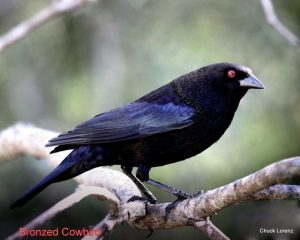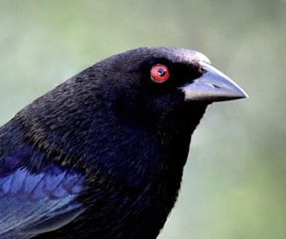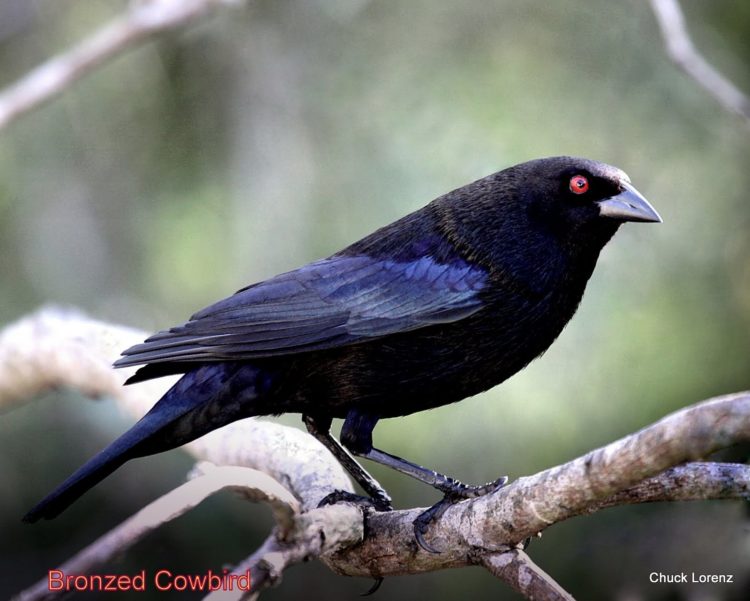
A bronzed cowbird is not a bad bird for depositing her eggs in the nest of an unwitting host, whose own brood often dies. No, the cowbird, like ourselves, does what it does to survive and prosper.
An obligate brood parasite—like about 1% of bird species, including some cuckoos—a cowbird never constructs a nest. After scouting out a prime host, she slips her eggs into the unsuspecting bird’s nest, sometimes destroying its inhabitants. Unable to distinguish cowbird eggs from their own, these duped foster parents feed and nurture often larger, earlier-to-hatch cowbird chicks, usually at the expense of their own, who, unable to compete, often die. It is not uncommon to spot a bright red cardinal tirelessly feeding a clamoring brown chick.
Appalled by this often-fatal trickery, some mistakenly brand cowbirds as murderers, forgetting that Nature is, as Alfred Lord Tennyson wrote, “red in tooth and claw.” Irate mockingbirds bombard birds, cats and people. Tiny hummingbirds fight fiercely, sometimes to the death, over a limited supply of blossoms.
Locally, the primary hosts of the bronzed cowbird appear to be green jays, long-billed thrashers, mockingbirds, northern cardinals, olive sparrows and Altamira orioles. Audubon’s orioles, which usually nest west of here, readily accept their eggs, while Bullock’s orioles reject them. Frequently parasitized species often attack nearby cowbirds.
The bronzed cowbird (Molothrus aeneus), which commonly breeds in the Valley, shares its genus with the smaller, more thoroughly studied brown-headed cowbird, which appears less frequently here. Cowbirds join grackles, meadowlarks and orioles in the blackbird family, Icteridae.
A courting male bronzed cowbird, his eyes like rubies embedded in black velvet, tosses back his head, his bronzy ruff ballooning like Dracula’s cape. Singing, he bounces, then hovers, helicopter-like, over the object of his desire.
Once a cowbird deposits her eggs in one or more nests, she closely monitors their progress. If the host removes her offering, a brown-headed cowbird often retaliates, demolishing the host’s eggs. Some would-be hosts, espying the thieves, build another nest atop their previous one, sometimes multiple times. One nest may contain both bronzed and brown-headed cowbird eggs.
A host feeds a bronzed cowbird for about two weeks after it leaves the nest. Interestingly, the cowbird somehow learns to be a cowbird, not a cardinal or a green jay. Young cowbirds do spend time foraging alone, and researchers have witnessed them interacting with adults, but whether these adults see them as unwary cowbird fledglings or as prospective mates is unclear.

Why don’t cowbirds build nests like other self-respecting birds? One prevalent, but debated, theory holds that their once nomadic lives among herds of buffalo, then cattle—large beasts that stir up insects—made nest-building inconvenient and taxing. Also, presumably, the dearth of large, traveling herds led cowbirds to spread and diversify their habits, to the detriment of many songbirds. Then again, natural selection may simply favor this parasitism, which enables cowbirds to conserve energy and produce more offspring.
Though tempting, removing cowbird eggs from a host’s nest is illegal under the Migratory Bird Treaty Act unless one has a permit intended to protect an endangered species. And it may be counterproductive. Sometimes dubbed “mafiosos”, brown-headed cowbirds have destroyed nests that researchers have tampered with.
We cannot blame cowbirds, residents of our planet for millions of years, for decimating populations of certain birds. It is our responsibility, as the species currently in charge, to respect and preserve their habitats.
